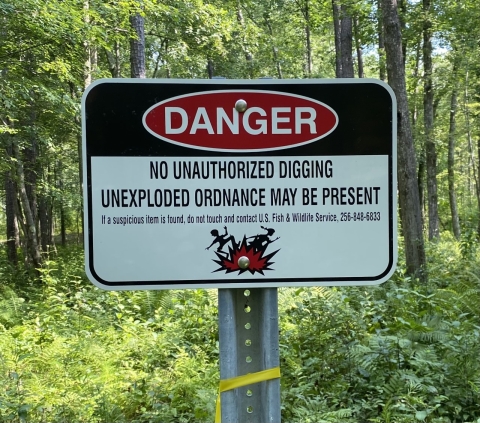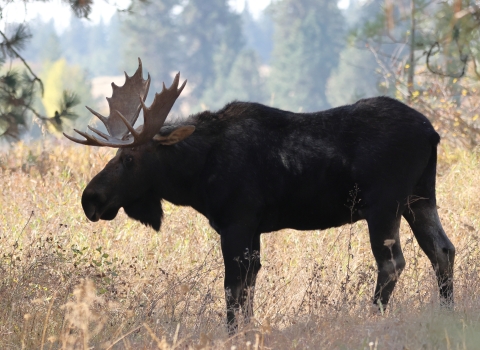Anniston, Alabama – For 100 years the bombs fell, poisons spread, and fires raged across the mountainous longleaf pine forests. Yet, through it all, a lovely, delicate, and federally threatened flower persevered.
The white fringeless orchid came very close to disappearing from its boggy home at Fort McClellan, a former Army base in northeast Alabama. In 2017 only three orchids were counted at the rolling and forested installation known today as the Mountain Longleaf National Wildlife Refuge. Earlier this year, 343 flowers, some in breathtakingly beautiful clusters of white and green, sprouted from mossy patches and spongy peat.
Years of habitat-restoration work is paying off in what, at first blush, appears to be the most inhospitable of terrains.
“We are seeing the results of five or six years of hard work,” said Ricky Ingram, the project leader for the series of north Alabama wildlife refuges that includes Mountain Longleaf. “It shows that what we’re doing is working and what we’re in it for.”
But the very elements that ravaged the land for decades – the munitions and the fires – are credited today with the orchids’ success. The ecological irony isn’t lost on Patrick Thompson.
“It’s very possible that live fire from the adjacent artillery range provided the fire these rare plants needed during the latter half of the 1900s when forest fires were heavily suppressed,” said Thompson, coordinator of the Alabama Plant Conservation Alliance. “Lots of Alabama’s threatened and endangered plant species are now rare because the natural fire regime has been interrupted.”
‘Field day’
Thompson and crew – a dozen biologists and plant-lovers from the U.S. Fish and Wildlife Service (Service) and Auburn University – marched methodically across the Marchetta Seep in search of orchids. In groups of twos and threes they divided the sodden field of sphagnum moss, brier bushes, red maples, and loblolly pines into transects. They set about counting the perennial herb with downy, white petals clustered at the end of long stems. The humidity was high; the morning’s heat was rising, too. The towering longleaf pines on adjoining hillsides offered little relief.
Ingram and Abbey Harris, a Service intern, started slowly. Others, on the meadow’s southernmost flank, discovered, and loudly announced, cluster upon cluster of Platanthera integrilabia. Not until Ingram and Harris reached the back of the bog, a hundred yards in, did the so-called monkey-faced orchid show its face. Or faces.
“I see three right beside us, four, maybe five,” Ingram said as he catalogued the cluster on a GPS to be mapped later.
“There’s one,” chimed in Harris.
“Here’s some more,” Ingram added, cheerfully. “We’re getting our turn now. It’s a field day – literally.”
The teams tackled another swampy field at the confluence of two nearby creeks. A few more flowers were found. And then, the final count:
“We’ve got 343 total,” Ingram said, thunder rumbling in the distance.
“No way,” said Thompson.
“Yup,” added Ingram. “It goes up every year.”
The Service, Auburn University, and others began actively managing the Marchetta Seep six years ago, pruning trees and understory with brush cutters, weed-whackers, and herbicides. The bog was either too wet, or too dry, for prescribed fire. A more open canopy allowed the sun to shine through and the orchids to flourish. From three flowers in 2017, to 37 the next year, to 212 last year.
“The management is working,” said Thompson, who’s also the curator of the Donald E. Davis Arboretum at Auburn. “We’re seeing a real sharp increase in flowering stems. That curve could sweep up into the thousands of flowers once this generation grows up.” Or not. The threats are manifold. Logging. Invasive species, including fast-spreading plants and wild hogs. Stem-eating deer. Poachers. Road-building. Over-development. Climate change – droughts, higher temperatures, inundating rains – harms the fragile orchids more than most federally listed plant species.
Alabama, Georgia, Kentucky, Mississippi, South Carolina, and Tennessee were home to 86 “occurrences” of the orchids in early 2021, according to its Species Status Assessment Report written by the Service. The Cumberland Plateau that stretches from Kentucky, across Tennessee and into Alabama (and a bit of Georgia) is where most of the plants are found. For now.
“The number of populations predicted to be extant in 50 years would decline under all scenarios because some populations are predicted to be extirpated as a result of development or logging and/or lack of protection or habitat management,” reads the species report.
Fire to flowers
The 9,016-acre Mountain Longleaf refuge, though, will likely be the exception. Carved from the remains of the sprawling Army training base, the refuge was established in 2003 largely to preserve its wondrous montane longleaf pine forest. The pines, typically found along coastal plains, provide habitat for deer, turkey, bobwhite quail, bobcats, gray bats and a slew of neotropical migratory birds. The ecologically rare spring seeps abound with plants and flowers.
The refuge affords residents of nearby Anniston a lovely hiking and birdwatching preserve. Hunting, too, is allowed. Refuge staff periodically burn the longleaf and hardwood forests.
Fire, after all, was Fort McClellan’s forte. The U.S. War Department established the base in 1917, while World War I raged, as a rapid-mobilization base and National Guard facility. Nearly a half-million soldiers trained at the fort during World War II. Pelham Range, where the refuge now sits, was used for live-fire exercises. Tons of unexploded ordnance remained embedded in the fields and hills when the fort was turned over to the Service. Most has been remediated. Onethird of the refuge, though, remains off-limits as the Army continues to remove the still dangerous shells. Explosions, occasionally, resound during prescribed burns. After the war, and until the base’s closure in 1999, the fort trained soldiers in chemical, biological and radiological weapons, including napalm, Agent Orange, and blister agents.
Fires, generated by the artillery, helped preserve the longleaf pine forests and the white fringeless orchids. When the base closed, though, the still-fragile ecosystems suffered.
“The orchid population was in decline because of the lack of fire,” Ingram said. “Our goal, long term, is to get into a fire cycle and never lose the fringeless orchid population at Mountain Longleaf.”
And if we do? Will it matter? Will anybody, beyond biologists, care if a swampy flower disappears?
“You’ve got to watch out for that slippery slope when you start losing species,” Thompson said. “What happens when the world no longer provides us with those ecological services? And, personally, I also want my grandkids to see monkey-faced orchids.”




